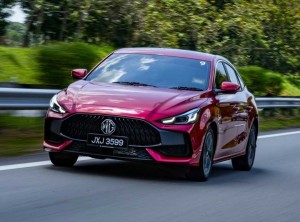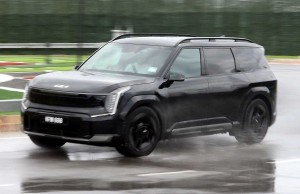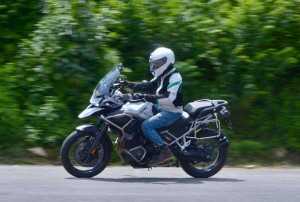Electrification is the path Honda has set itself on and there’s no turning back.
By 2020, the Japanese marque will introduce its full EV car, the Honda e in Europe and becoming less dependent on combustion-only vehicles with its hybrid powertrains.
During the recent Tokyo Motor Show 2019, members of the media were taken to the Twin Ring Motegi racetrack at Tochigi Prefecture to test drive Honda’s hybrid vehicles as well as experience the capabilities of the Honda Sensing safety system.
As luck would have it, Japan was seized with a small typhoon on the day of the test drives.
It was no cause for major concern though as the activities went on as planned with the exception of some of the Honda Sensing activities.
However, it was replaced with another very fun activity instead - driving the new Honda N-Box. But more on that later.

Honda N Box
It rained relentlessly the whole day and kept getting stronger towards the evening.
The test area was an open carpark which had been laid out with cones to form a circuit with a lot of short, sharp and long bends and corners culminating in a long straight towards the end.
The first car we tested was the Honda Insight EX variant, the top-of the-range Insight sold in Japan at the moment.
The Insight looks much more regal and sleek with its bold grille with horizontal slats and fastback design and the size of the car is comparable to the current Civic.
It was under the hood which made the Insight stand out as it comes with a Sport Hybrid i-MMD (intelligent Multi Mode Drive) powertrain consisting of a 1.5L turbo engine coupled with an electric two-motor hybrid system mated to an E-CVT transmission.
The electric motor produced 131PS and 267Nm of torque while the combustion engine outputs 109PS and 134Nm of torque.
The interior of the Insight was plush and premium with a design we have yet to see in our models here in Malaysia.

Honda Insight
The instrument cluster was fully digital and there was no gear lever to set the car to drive. It had been replaced instead with a series of buttons.
So with a push of a button we were off. It was noticeably quiet and all one could hear was the rain beating down on the car with the monotonous swish of the windscreen wipers.
The Insight proved to be responsive with plenty of torque. It was also sharp in its steering and nimble enough for a sedan.
We had three laps around the coned-circuit and we opened the accelerator and there was a sporty but muted exhaust note.
It was hard to tell with the noise the rain was making.
Even under wet conditions, the car performed admirably and the hybrid system is definitely welcome for its quietness and excess torque.

Honda Insight
The next was the Honda CR-V HYBRID EX Masterpiece, a top specced variant in Japan as well.
Unlike the Insight, this was an SUV with 4WD while the former was only two-wheel drive. This CR-V also had the Sport Hybrid i-MMD powertrain but with a bigger displacement for the combustion engine - a 2.0L turbo engine which outputs 145PS and 175Nm of torque.
The twin-electric motor on the other hand, pushes out 184PS and 315Nm of torque.
The difference in power was immediately noticeable. A slight tap to the accelerator and off it went enthusiastically. With such twisting force and grunt, the CR-V also had brakes with a lot of bite which was exactly what a car with this power needs.
The CR-V also handled very well around the track although it was float-y at the sharper turns and bends but that is to be expected for such a tall car.
Also, the interior of the CR-V was also exceptional with wood trim, soft-touch material, comfort and high-level of quietness.

Honda CR-V HYBRID EX Masterpiece
These were the only two cars that showcased Honda’s advancement into its hybrid drive system.
The final car, which was not part of the original test drive, was the new N-Box which features a 660cc engine. It’s a popular Kei car in Japan for its spaciousness (I could fully stretch my arms above my head), functionality and small size.
It only has 64PS and 104Nm of torque but was the most fun around the circuit because of its low center of gravity.
Despite its small engine, it didn’t feel underpowered and the car handled like a dream and all the media present were just having a good time throwing this car about.
Finally, as the rain got heavier and the day darker we had one final test and that was a short but eye-opening nonetheless about the Adaptive Cruise Control (ACC) with Low-Speed Follow (LSF) as part of the Honda Sensing suite.
Here, we got behind the wheel of the Insight, turned on the ACC and it would follow the car in front without having to press the accelerator.
This system worked so well (and mind you it was dark and pouring it) that if the car in front was slowing down, the Insight would slow down with it to a full stop and continue again when the car in front began moving again.
This is a very useful application and I can see how it will work very well for those caught in bumper-to-bumper traffic. This means you would only have to steer without ever having to press the accelerator or brakes.
Of course, you would still need the patience to get through the traffic jam.
It was obvious to me that Honda was not just showing-off its hybrid and electric technology and advances in vehicle safety. It is developing these technologies holistically to improve the quality of life for those who use its vehicles and reducing emissions for a cleaner, safer and more thoughtful future for all of us.

Honda Insight

Honda Insight












